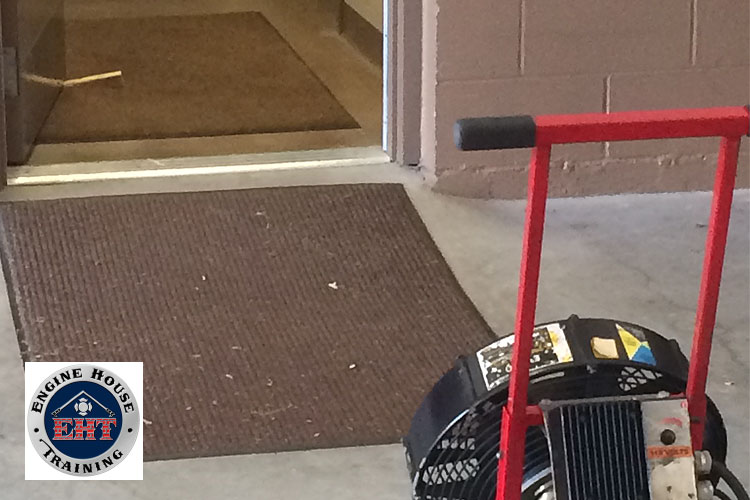
Throw Back to Basics Training Drill | By Brian Zaitz
Fans have become synonymous with fire service ventilation, however this connotation can sometimes lead to confusion on and improper tactics. The positive pressure ventilation (PPV) fan is the most commonly found fire service fan. It works by forcing air into a structure, creating a “higher pressure” inside the structure which forces the interior air to the “lower pressure” outside the structure through an exit portal.
Two keys are the pressure and portal: the outside air being forced in at higher pressure pushes not only the inside air out but it also takes out the contaminants such as smoke and toxins to the outside, which dilutes with the copious amounts of outside air in the atmosphere. For this reason it is not valid to say ventilation is complete or effective based solely on visibility; it is important to also to take atmospheric gas readings to determine oxygen, hydrogen cyanide, and carbon monoxide levels. These latter are the true indicators of effective ventilation or air exchange.
The other aspect of PPV fan use is the need for an exit portal. Without an exit portal or opening away from the PPV fan, the system will not function properly. Remember, the system works off pressure, thus there should only be one opening to allow for the building of pressure in the structure. If every window is out and the roof is off the structure, the fan may move some smoke and air at the entry point, however it will not be able to truly create pressure within the structure. When ventilating an home or even apartment building with a common hallway, ventilate one room or apartment at a time. It may seem more time-consuming, but it will be quicker and much more efficient.
When placing the fan, pick a location that has or will have an opening distant from the entry. For example, if you set the fan up at the Side B man-door, the exit portal should be on side A, C, or D. This prevents recontamination of the area by recirculating the building exhaust back throughout the structure via the fan. Place the fan approximately six to eight feet away from the door so as to create a “cone of air” around the door. This is to encapsulate the opening and again assist in creating that interior pressure. Prior to turning the fan on, ensure you have an exit portal and that everyone on the fireground is aware that you are about to begin positive-pressure fan use. Turn the fan on and throttle the unit up to optimal RPM. With many of today’s fans being electric this is often a simple dial or switch on the top of the fan. If it is gas, simply adjust the throttle arm to allow for full RPM. Once in place, keep the area clear and open. Avoid having the opening used as a entry point for firefighters trying to access the building, as this only reduces the efficiency of the system.
RELATED FIREFIGHTER TRAINING
- Drills You Won’t Find in the Books: The Dancing PPV Fan Drill
- PPV in Single-Family Dwellings: Not the Only Option
- “White Ghost” and PPV
As with any tool in the fire service it is critical to know when, how and why to use it. The PPV fan is more than just a tool to move air. It can dramatically improve or deteriorate your fireground depending again on when, how, and why it is used. Take some time to get out your fan and fully understand the concept of PPV usage on the fireground.
Download this training bulletin as a PDF HERE (208 KB)
Brian Zaitz  is a 15-year student of the fire service and the Captain-Training Officer with the Metro West Fire Protection District. Zaitz is also an instructor with Engine House Training, LLC , an instructor at the St. Louis County Fire Academy, and the Board of Director with the International Society of Fire Service Instructors. He has several degrees including an associates in paramedic technology, a bachelor’s in fire science management, and master’s in human resource development. Zaitz is also a credentialed chief training officer through the Center for Public Safety Excellence as well as a student of the National Fire Academy’s Executive Fire Officer Program.
is a 15-year student of the fire service and the Captain-Training Officer with the Metro West Fire Protection District. Zaitz is also an instructor with Engine House Training, LLC , an instructor at the St. Louis County Fire Academy, and the Board of Director with the International Society of Fire Service Instructors. He has several degrees including an associates in paramedic technology, a bachelor’s in fire science management, and master’s in human resource development. Zaitz is also a credentialed chief training officer through the Center for Public Safety Excellence as well as a student of the National Fire Academy’s Executive Fire Officer Program.
MORE THROW BACK TO BASICS

